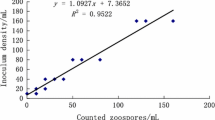Summary
The plant-infection technique for the estimation of rhizobia, in which small-seeded hosts are grown on agar within test-tubes, is applicable to soils with a moderate rhizobial population (in the order of at least 100/g). Account might have to be taken of “skips” (less diluted: negative, when more diluted are positive) likely to result, at least in part, from unfavourable conditions for rhizobial survival, multiplication or nodulation. Because of such effects, a sparse population (in the order of (10/g) may not be detected even without dilution (1 g soil per plant tube). Localisation of rhizobia in the soil is likely to be important in determining contact with the plant roots in the dilution count and in sampling from the field. Difficulties with sparsely populated soils can be partly overcome by carefully conducted direct sowings of sterilised seed, preferably in the confines of cores, either left in the field or brought back to the glasshouse.
Similar content being viewed by others
References
Brockwell, J., Accuracy of a plant-infection technique for counting populations ofRhizobium trifolii. Applied Microbiol.11, 377–383 (1963).
Date, R. A. and Vincent, J. M., Determination of the number of root-nodule bacteria in the presence of other organisms. Australian J. Exp. Agr. Animal Husbandry2, 5–7 (1962).
Fisher, R. A. and Yates, F., Statistical Tables for Biological, Agricultural and Medical Research. Oliver and Boyd, London (1953).
Gibbons, F. R. and Hallsworth, E. G., Map of the soils of the Namoi Region.In ‘The Namoi Region. A preliminary Survey of Resources’. New South Wales Premier's Dept. (1950).
Halvorsen, H. O. and Ziegler, N. R., Application of statistics to problems in bacteriology. I. A means of determining bacterial populations by the dilution method. J. Bacteriol.25, 101–121 (1933).
Hely, F. W., Bergersen, F. J. and Brockwell, J., Microbial antagonism in the rhizosphere as a factor in the failure of inoculation of subterranean clover. Australian J. Agr. Research8, 24–44 (1957).
Jensen, H. L., Nitrogen fixation in leguminous plants. I. General characters of root nodule bacteria isolated from species ofMedicago andTrifolium in Australia. Proc. Linn. Soc. N.S.W.66, 98–108 (1942).
Leonard, L. T., A simple assembly for use in testing cultures of rhizobia. J. Bacteriol45, 523–525 (1943).
Marquez, R. G., Studies of the Root Nodule Bacteria. Thesis, M.Sc. Agr., Univ. Sydney (1956).
Purchase, Hilary F. and Nutman, P. S., Studies of the physiology of nodule formation. VI. The influence of bacterial numbers in the rhizosphere on nodule initiation. Ann. Botany21, 439–454 (1957).
Tuzimura, K. and Watanabe, I., Estimation of number of root-nodule bacteria by a nodulation-dilution frequency method. Ecological studies ofRhizobium in soils. (Part I). Soil Sci. Plant Nutr.7, 61–65 (1961).
Vincent, J. M., and Crofts, F. C., Pasture improvement in the Pilliga. Rep. No. 3, School of Agriculture, Univ. Sydney (1958).
Wilson, J. K., Legume bacteria population of the soil. J. Am. Soc. Agron.18, 911–919 (1926).
Author information
Authors and Affiliations
Rights and permissions
About this article
Cite this article
Thompson, J.A., Vincent, J.M. Methods of detection and estimation of rhizobia in soil. Plant Soil 26, 72–84 (1967). https://doi.org/10.1007/BF01978676
Received:
Issue Date:
DOI: https://doi.org/10.1007/BF01978676




